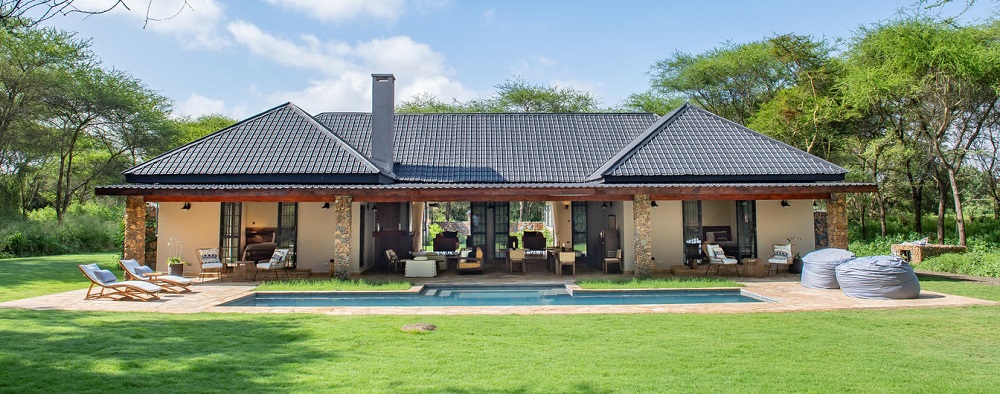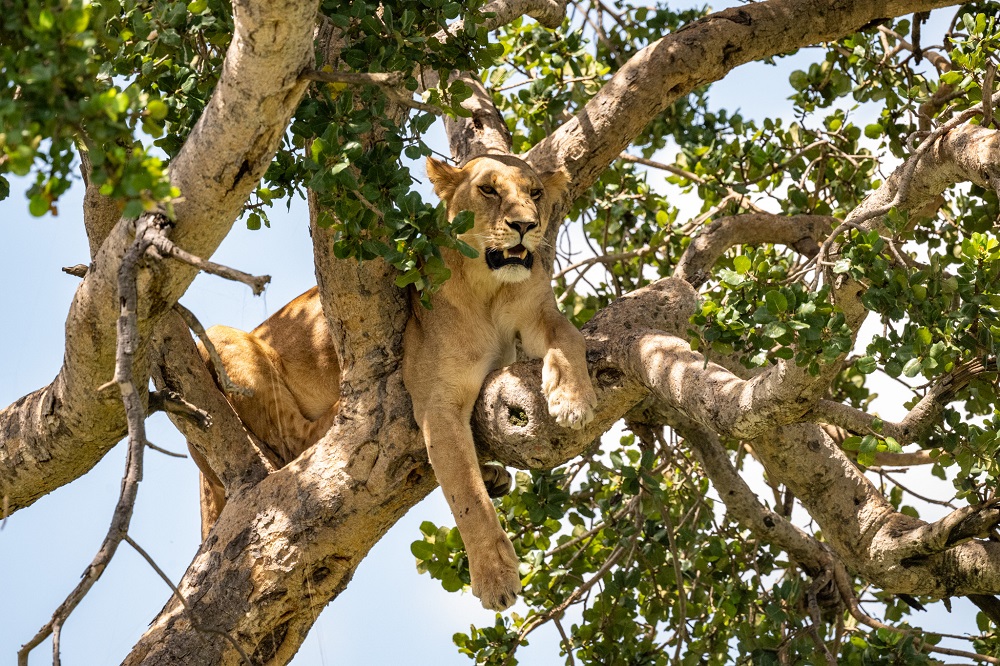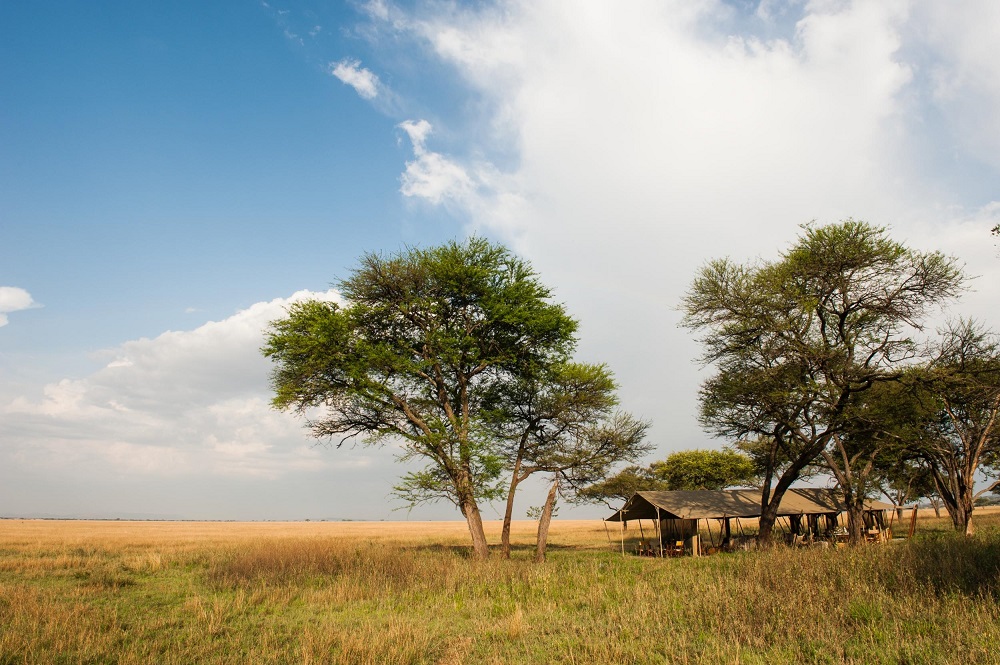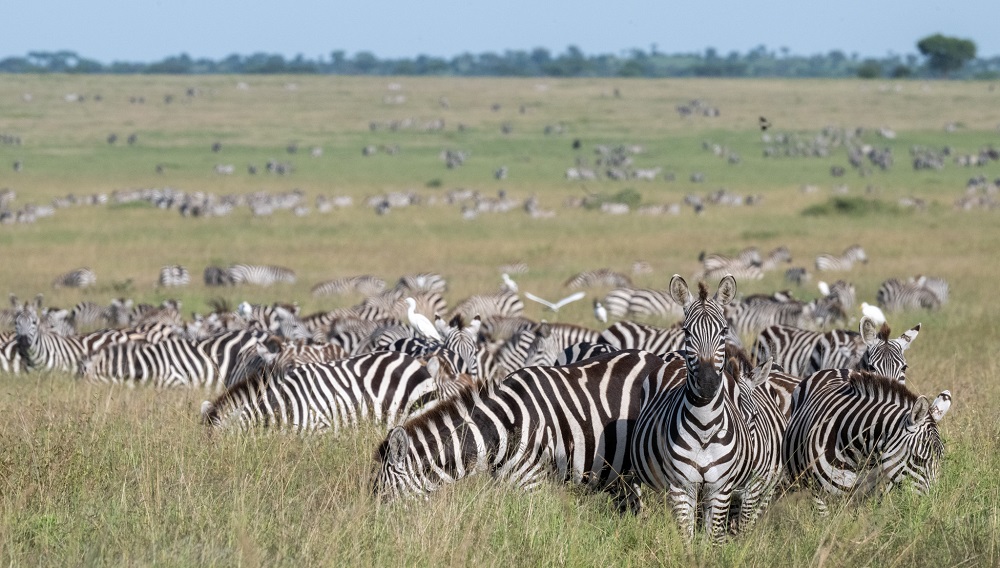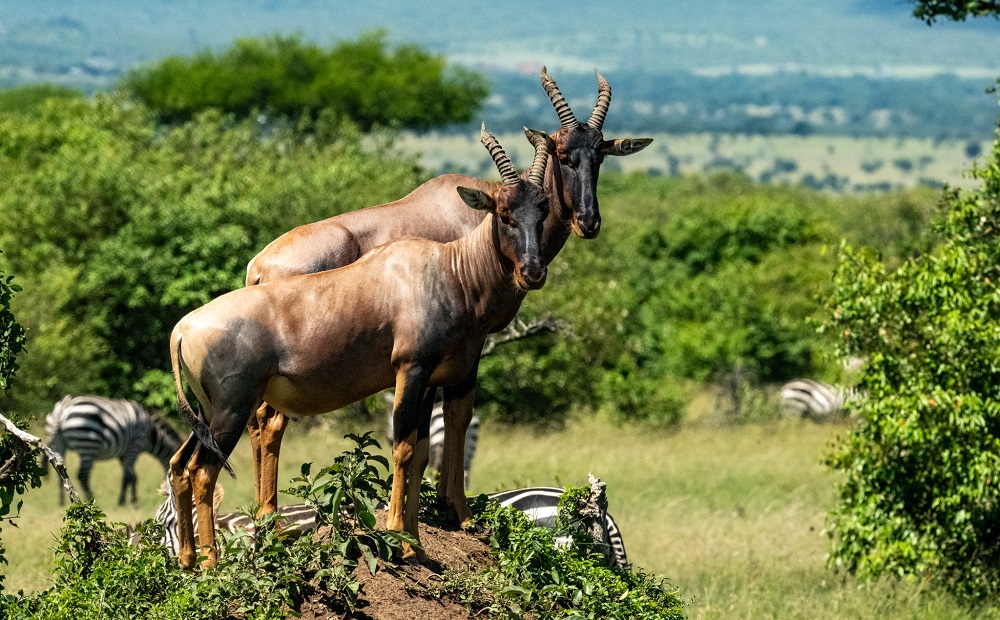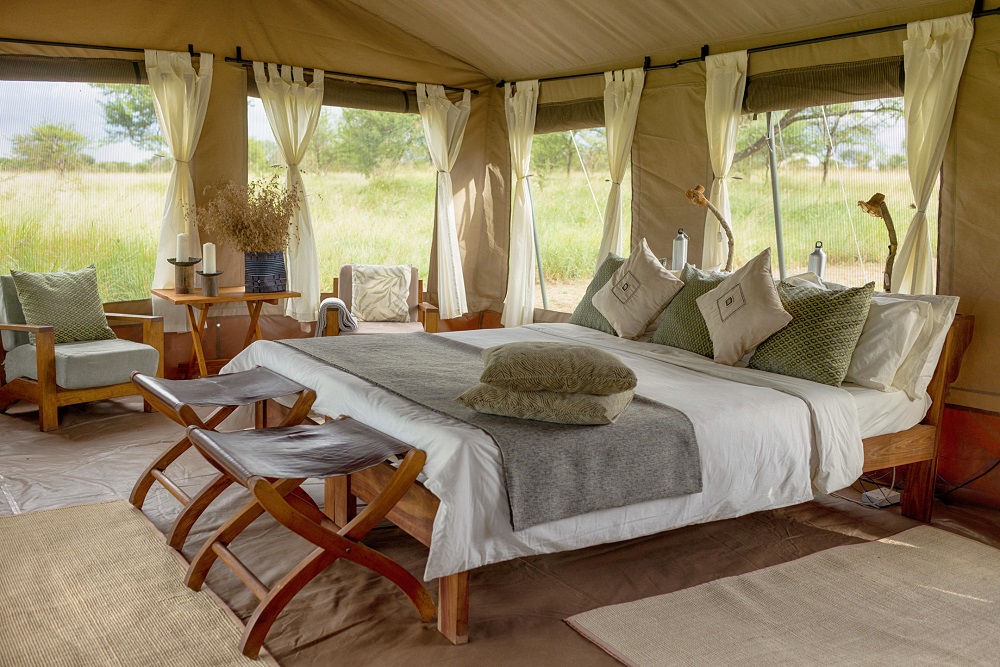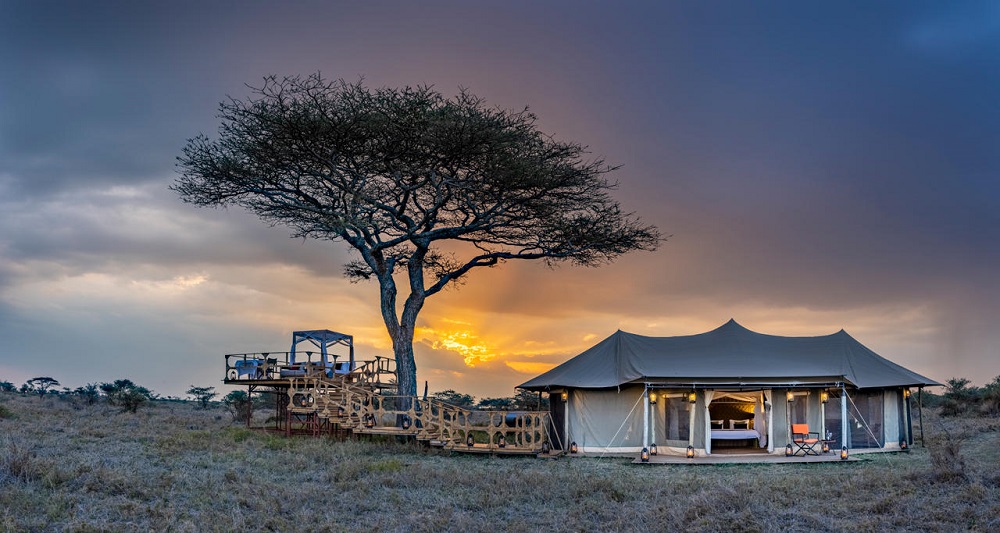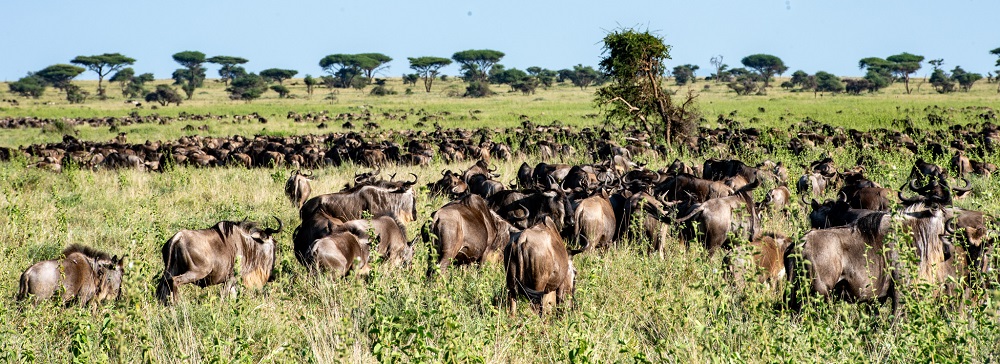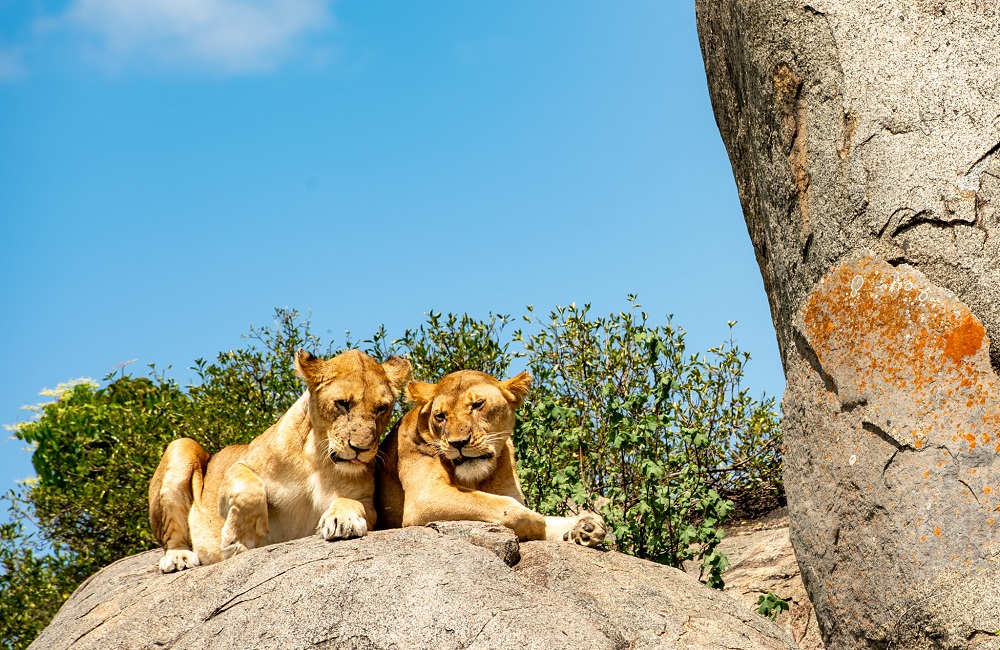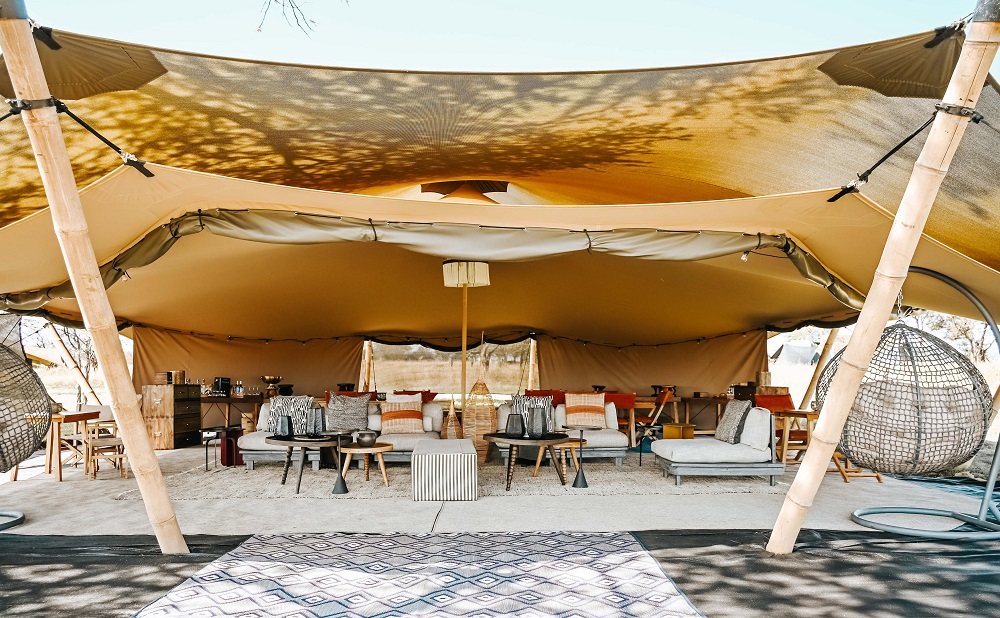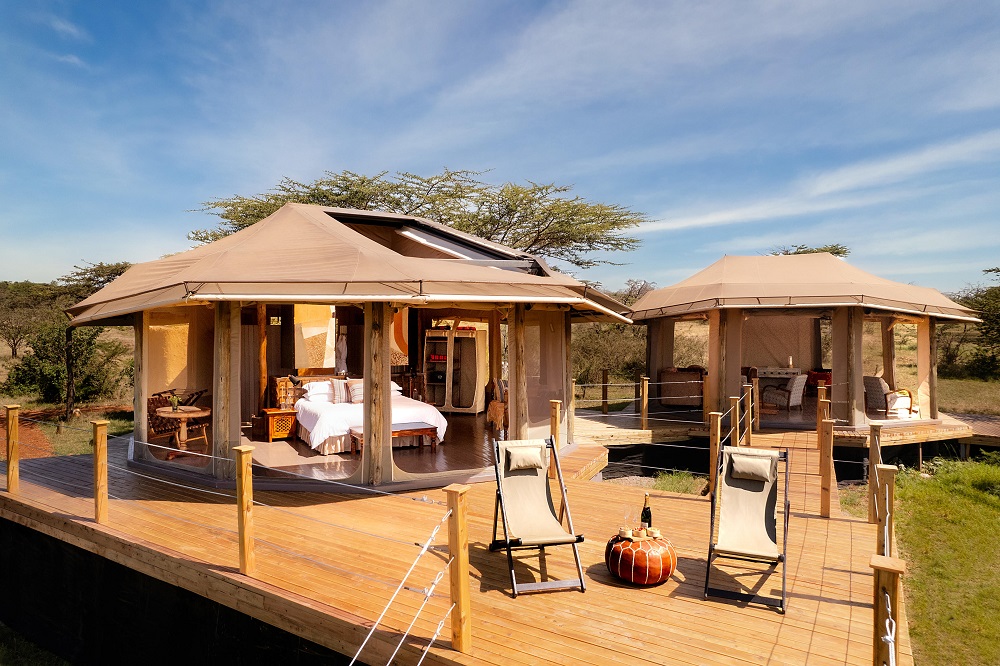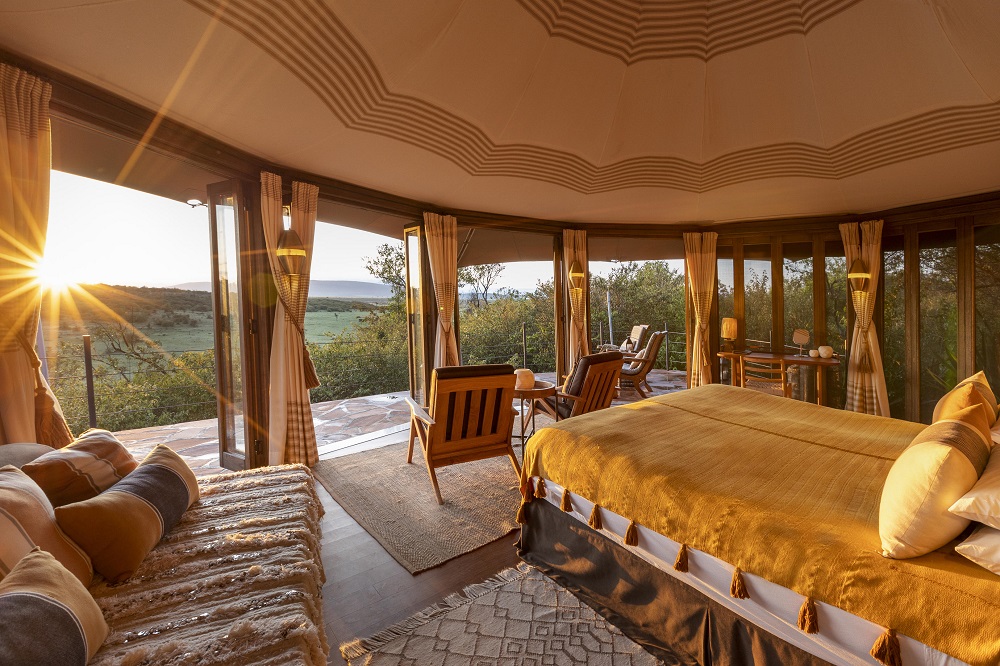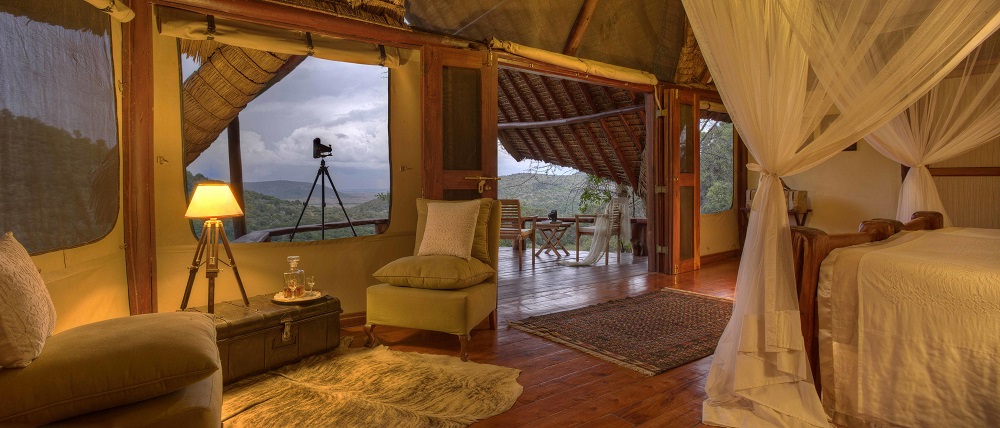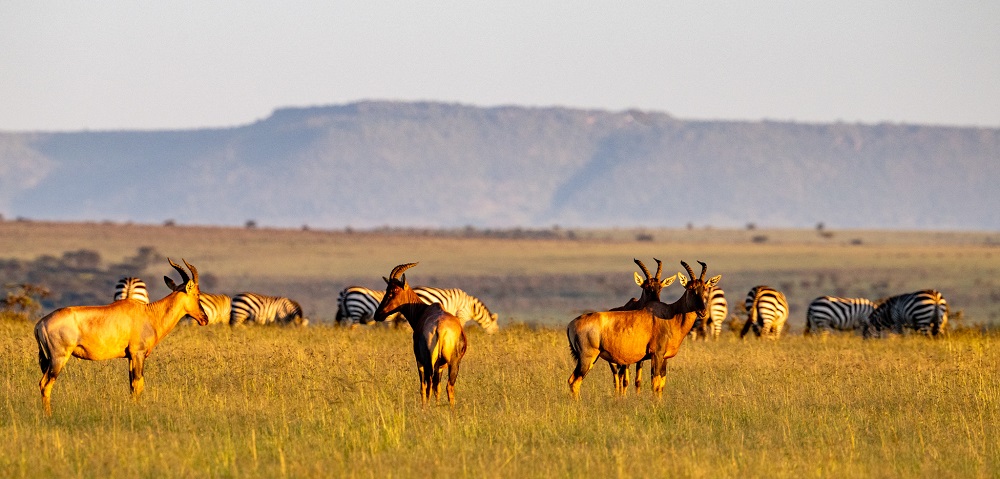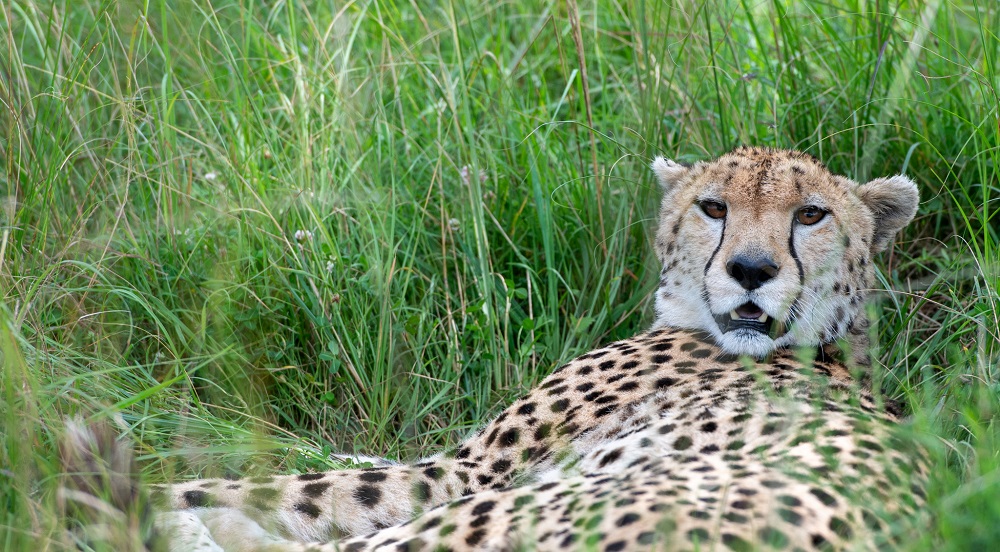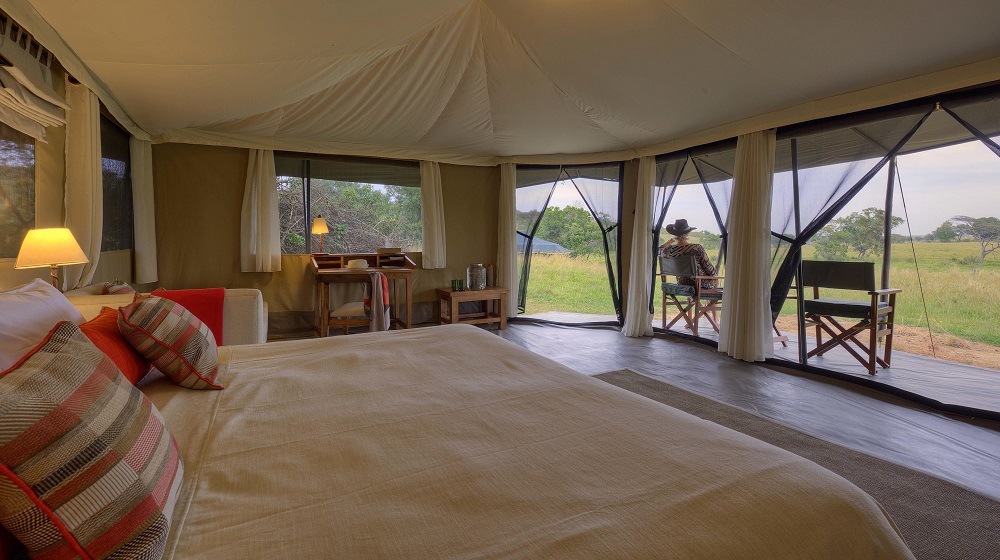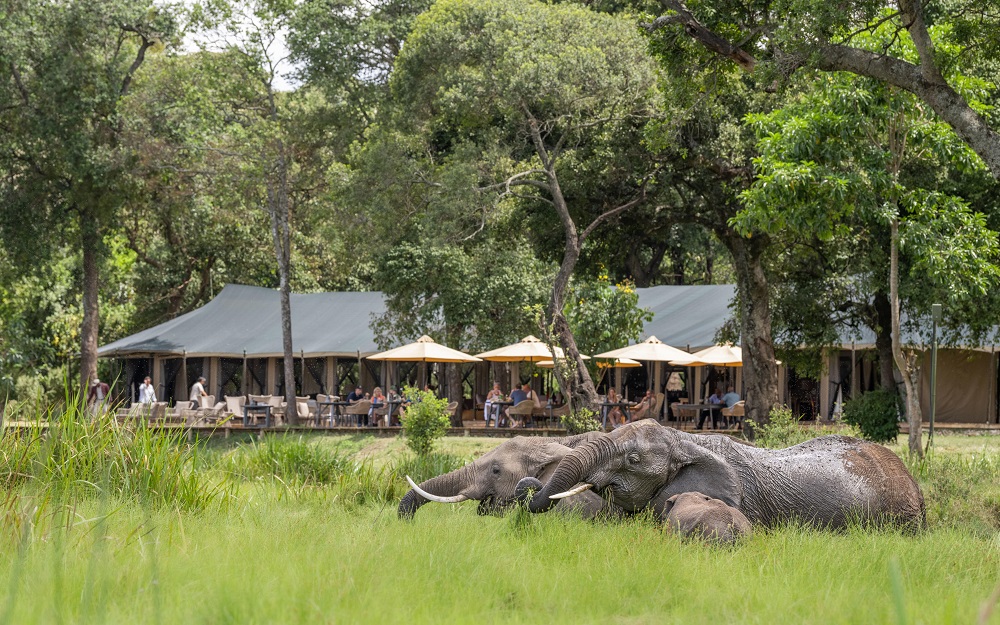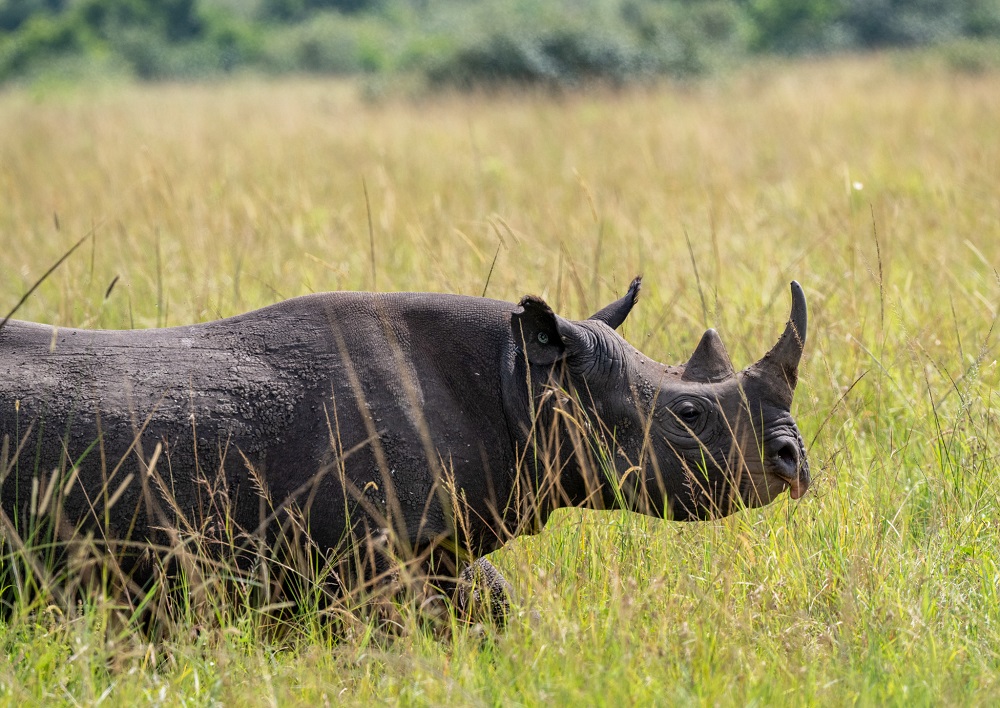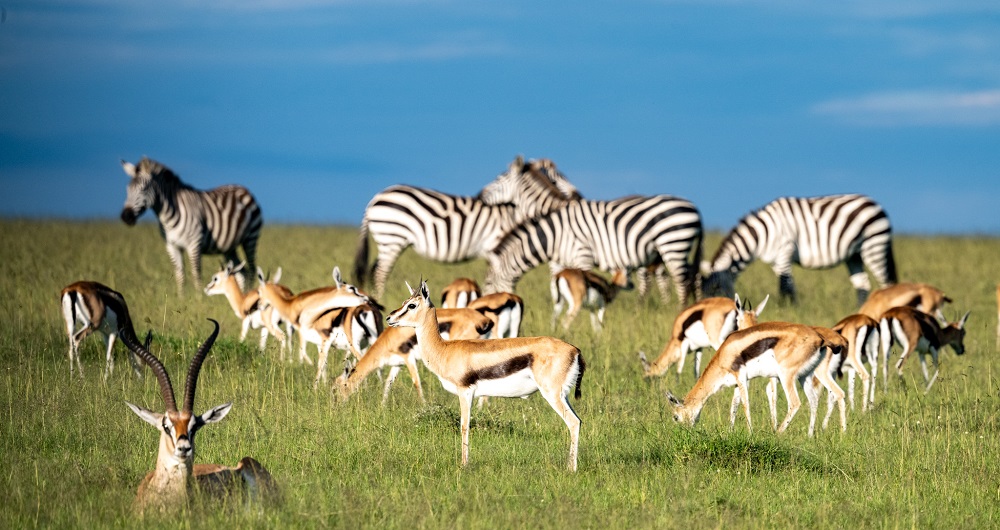Returning to Tanzania's Serengeti National Park and Kenya's Masai Mara - May 2024
In more than 30 years of regular visits to East Africa, Kathy and I had never seen it as wet as this last May. To say that it was exceptionally wet is an understatement. Every game drive was sloppy, every off-road excursion an adventure. Leading to a few tense moments when the 4-wheel drive vehicles (mostly Toyota Landcruisers but also a Landrover on one transfer drive) were pushed to the limit of their ability to negotiate unbelievably difficult terrain. The guides came through with flying colors and we only got stuck properly once. For maybe 20 minutes or so. No big deal.
Beyond affecting our views of smaller mammals and cats like serval, leopards and cheetahs, the resulting tall grass and dense vegetation everywhere delayed the annual wildebeest migration by a month or so. If you’re a wildebeest, why would you leave one place for another if there’s still plenty of what you need in the way of vegetation and water right where you are.
The high grass made game viewing super challenging. To the point that we didn’t have good views of any cheetahs in the Serengeti (so unusual!) and likewise leopards. On a couple of the game drives in the central Seronera area I hardly took my cameras out of the bag – never a good sign. All this of course will play into future decisions as to the best timing for visiting specific areas.
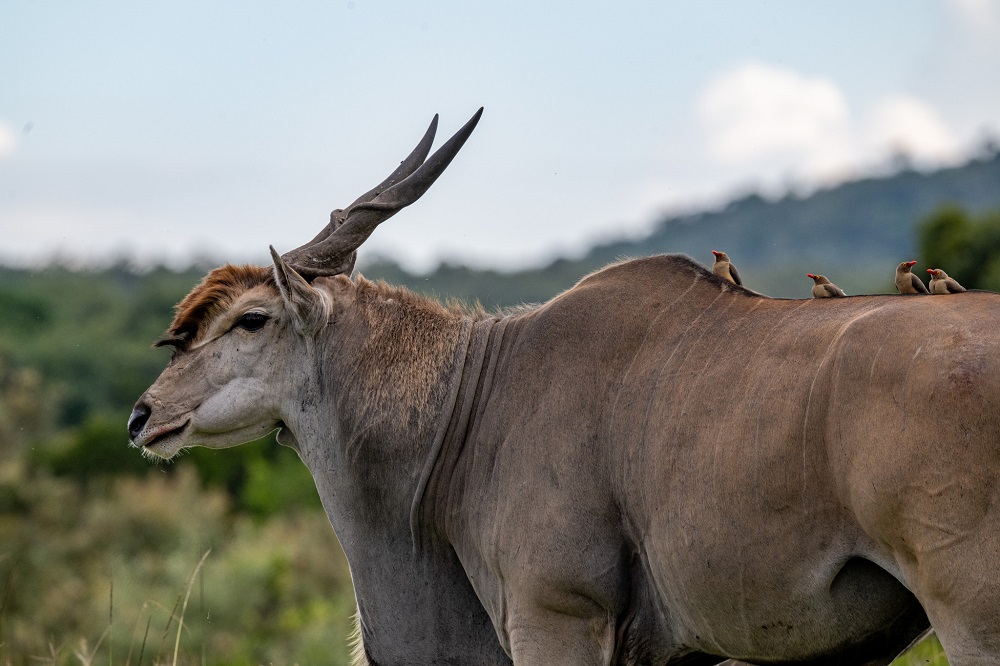
Our experience at three of the four properties which we visited in the Serengeti was negatively impacted by the presence of just too many tsetse flies. More than just once, we got hammered coming and going into and out of camp and on a few occasions, even right inside the camp grounds. To the point where the usual enjoyment and fun associated with game drives were negatively affected by the tsetse fly threat.
We will be paying close attention to this issue in order to provide prospective travelers with the right advice and guidance. The extraordinary long and heavy rainy season this year resulted in many areas having stagnant water which creates favorable conditions for tsetse fly breeding. Usually, when TANAPA (Tanzania Park Authority) conducts controlled burning of certain areas in the Serengeti, they eradicate a huge number of the tsetse flies in the process. Due to the much longer than usual duration of the long rains this year, there was no burning and the results are evident. Lots of thickets and overgrown grass and bushes – and plenty of tsetse flies.
The tsetses are not as much of an issue in the southern Serengeti; at least they weren’t the last time we were there, in February 2023. So we will continue to recommend to prospective travelers to travel there (short-grass plains in the Ndutu area) for the calving season and to combine their stay with a few days in the Seronera area. Where we will be using properties where we know tsetse flies won’t be an issue. Likewise, there are usually a few pockets of dense forests in the northern Serengeti in the Kogatende area and elsewhere, where a few tsetse flies can be expected. Nothing that can’t be managed with a bit of caution and by wearing long sleeved shirts and protecting your ankles with long, thick socks and tucking in the trousers.
Getting there
Getting to Kilimanjaro Airport for the start of our Tanzania trip was not routine this time around. Anything but. It started on a catastrophic note when an inept airport employee at JFK crashed a jetway into the engine of our Kenya Airways Boeing 787 Dreamliner. Which, needless to say, caused an immediate cancellation of the flight. I won’t bore you with the details but this resulted in an arduous trip on Ethiopian Air via Abidjan, Addis Ababa and Nairobi. Where we arrived at one in the morning instead of 10 am the previous day. On a plus note, when we eventually made it to Tanzania on Monday May 13, we were first in the immigration line and we completed the process in less than 15 minutes, start to finish. A reminder: take your boarding pass with you when leaving your plane at JRO Airport; you will be asked for it upon entering the terminal building.
Hamerkop House, Arusha
We enjoyed a peaceful overnight stay – much needed after the ordeal of getting there – at Lemala’s Hamerkop House, on the outskirts of Arusha. The property is clearly well run, with a great staff, and the food was excellent. The chef got it exactly right for me: ugali and two sides. Those being beans in a coconut-based sauce (Maharagwe) and the local version of spinach with some onions. The road to get to Hamerkop House was not the best. Clearly, the property will be a good option for guests who can fly out of the nearby Dolly airstrip the following morning, directly to the Serengeti.
Serengeti Safari Camp, Grumeti
It took just about 50 minutes in a Cessna Caravan to fly from Arusha to Seronera with brief stops at Kilimanjaro Airport and at Lake Manyara. As before, it was exciting to take off from Lake Manyara with the earth literally dropping away precipitously as the aircraft reached the edge of the Rift Valley wall. Approaching the Seronera airstrip it was clear that the migration was not around – yet. Even so, the long road transfer to Nomad’s Serengeti Safari Camp delivered some surprisingly good game viewing under challenging conditions. Some of the highlights were lions in a tree, several breeding herds of elephants and large herds of zebra and other plains game.
One thing which we noticed almost immediately at Serengeti Safari Camp: the quality and variety of the food and its presentation have improved markedly since the last time. Our Nomad guide Amos Noah was top-notch and did all the right things. Of the four guides we had in the Serengeti, he was also the only one who knew all the birds. So high marks on that.
On our full day in the area, we headed across the Grumeti River towards the Grumeti Reserve. The area was about as spectacular as it gets anywhere in Africa. Rolling hills in so many shades of green. Trees silhouetted against the skyline. Vast open plains, endless vistas. Misty blue hills on the horizon.
Just when you think you’ve seen pretty much everything in Africa, a morning outing in a new or unfamiliar setting will blow your socks off. As it did to us on this Tuesday morning in the Serengeti. Quite early this morning, not far from Legendary’s Mila Tented Camp, we saw a migrating herd of at least 5,000 zebras slowly winding their way from our left to our right. Moving slowly and ever so quietly, lines of these dazzling black and white equines were making their way across the open plains, pausing to eat as they moved. It was mesmerizing to see so many of these sleek mammals following each other in a controlled but irregular manner, with groups lagging behind and others splintering off. Clearly, they were on the move. Zebras are often the harbingers of the great wildebeest migration, which we were to bump into a day or two later, a bit further south and east.
Not surprisingly, given the presence of so many zebras, we spotted first two and then three beautifully maned male lions and then four young females a little bit later that morning. There was more to come. Lots of elephants, including several good-sized herds. Also some large herds of buffalos and big mixed groups of topis, gazelles, impala and eland.
The all-round hospitality at Serengeti Safari Camp could not have been better and we were more than well taken care of. There were a few shortcomings such as no fans in the rooms and a somewhat rickety low pressure shower which had clearly seen better days. We were glad to learn that flush toilets would be installed at the various Serengeti Safari Camps in June this year.
On our way back to Seronera on our last morning at SSC, we found several small herds of elephants and groups of zebras in good light. The photographs demonstrated the importance of being out early enough to take advantage of the ‘golden hour’ in the morning. If you ever find yourself in a safari camp where the morning routine is a little bit too leisurely with – for example – breakfast at 7 am and departure from camp at 7:30, don’t hesitate to push back and request an earlier departure for your game drives. This is of course easier with a private vehicle and guide, but can even be done as long as everyone in your vehicle is on the same wavelength.
Wild Frontiers Serengeti Wilderness Camp
The road transfer from Seronera Airstrip to Wild Frontiers Serengeti Wilderness camp took about 45 minutes. For a good portion of the trip we found ourselves in a closed vehicle, with no air conditioning or proper ventilation, negotiating the tsetse fly belt. Not much fun. The camp itself was a spotlessly clean and very comfortable tented property with 12 rooms, as well as separate lounge and mess tents. There was pretty serviceable WiFi in the main area. The rooms are of a good size, clean and neat. Hot showers were available on demand. Lighting was on the dim side. The tent has a proper flush toilet.
We soon found out that it took almost an hour from the camp to reach the productive game viewing areas. As it turned out, game drives from Wild Frontiers Serengeti Wilderness Camp were disappointing to say the least. Inexplicably, our guide seemed to persist in driving around in areas dominated by stands of excessively high, thick grass. Not surprisingly, we saw hardly anything of note with the exception of a leopard on a branch in a tree, viewed from a long distance away. Clearly this area is not at its best until June. We got stuck in the mud late one morning but fortunately the guide was able to extricate us. Kathy and I enjoyed an impromptu al fresco lunch so it wasn’t all bad.
The food was tasty and ample, and the chef did a great job catering for my plant-based diet.
Entara Olmara Camp, Seronera
It took about two hours on a shockingly bad road from Seronera Airstrip to make it to Entara Olmara camp. Our driver-guide Said Kotoku impressed us from the very first moment we were introduced. He knew the birds, was enthusiastic, talked about and expounded on identifying characteristics, and he was clearly knowledgeable and experienced.
Olmara Camp itself makes a good impression, starting with a well-designed and slightly elevated lounge and dining areas with four spacious tents left and right. All rooms are in the process of being elevated as well. Four had been done and four were in progress at the time of our visit. Our room had a king-size bed with an effective mosquito net in a well insulated room. The bed was comfortable and there were several handy plug points. The shower at Olmara was one of the best I’ve seen on safari anywhere. The room had a flush toilet. The interior lighting was excellent. Packing space just so so.
The food was consistently good and well presented, with lots of choices. The staff members were friendly and helpful and kept me on the straight and narrow with the plant-based food choices. No butter for you…
Game drives out of Olmara
During the wet season – which was much longer than usual this year because of the El Nino weather pattern – game drives take a solid hour to get to the productive areas and quite frankly, there was not much to be seen on the drive there and back. A lot of thick grass.
On our first afternoon we found a couple of large bull elephants on the way back into camp; a fortuitous combination of storm light and a clean, uncluttered background resulted in a memorable photograph. Reminder to my photographer self: don’t give up on less than ideal conditions. Photo opportunities will present themselves as long as you keep looking for them.
On our full day at Olmara, we embarked on what turned out to be a monster all day game drive, all the way out to the Gol Koppies and beyond. Said drove a huge distance, setting out on a semi-circular route which included many of the game hotspots. It worked. By mid-morning we were smack in the middle of the wildebeest migration. It was an amazing sighting. Literally thousands of wildebeest in every direction, all around us in a 360 degree arc. Doing what wildebeest do which seems to be a combination of eating grass, running around erratically and regularly grunt-calling to maintain contact with a friend or family member. And always succeeding in looking a bit goofy because of their peculiar physique (skipped hind leg days at the gym too often) and homeliest of homely faces, making them truly incapable of managing a thoughtful look.
From late morning that day, we encountered one after another pride of lions. One group had several large males and a female with three cubs. Others were lying in thick grass at the base of rocky outcrops, or wedged into tree branches in an elevated spot with a view over the plains. We approached a coalition of three cheetahs in tall grass but for once I had to just ‘appreciate’ them – it was not a photo opportunity. Our mega day drive also produced hundreds, if not thousands of zebras, gazelles, eland, topi and hartebeest. We added several new birds to our trip list. In fact we hit the 100 species mark that very afternoon.
An extraordinary sighting on the day was watching a simply massive black necked spitting cobra hunting for frogs. We were just too far away for photography, but it didn’t matter. Observing the animal slowly winding its way between a bush and a rocky outcrop and then suddenly perking up as it found – and tried to kill – its toad prey – was spellbinding. All of this we both observed through our respective pairs of quality Swarovski binoculars. Without good binos this would have been a nothing event, and likely borderline frustrating using a mediocre pair.
Wilderness Usawa camp, Seronera
Our next and last stop in the Serengeti was Wilderness’ Usawa #2 tented camp, relatively close to Olmara. Due to some Byzantine Tanzania parks authorities rules, we had to drive all the way back to Seronera Airstrip from Olmara for the correct permits to be issued, and then back again (fortunately on a better road) to Usawa. A lot of seemingly wasteful energy expended in the process, not to mention further wear and tear on already dodgy roads.
Usawa is an upscale mobile camp with innovative design features, attractive and extremely comfortable rooms with low pressure showers (on demand), WiFi in the common area and in the rooms.
The camp is located in a good area for walking safaris, which is one of their specialties. The food was definitely a step above what we had experienced up to that point on the trip. Ambitious but well-executed and superbly presented.
Like the other Seronera area camps, the Usawa location is one hour plus from the best game viewing in the area at the time. Faced with the prospect of yet another lengthy drive – in an open vehicle – through areas with significant tsetse fly presence, we turned down the offer of another full day game drive.
Our morning game drive – with our capable guide James – the following day turned out to be better than anticipated with lots of elephants, nice groups of buffaloes, dozens of giraffes, topi, hartebeest, impala, and some great birds.
Saruni Wilderness and Saruni Leopard Hill, Naboisho
After a brief stopover in Nairobi with an overnight at House of Waine (excellent as always) in Karen, we flew with Safarilink from Wilson Airport to the Masai Mara.
From the Ol Seki Airstrip in Naboisho, it was about a 30-minute drive to Saruni Wilderness, which would be our first stop – for lunch. Saruni Wilderness camp is quite intimate with just five rooms. It has a small yet cozy and inviting dining and lounge area. The camp is solar powered. The tented rooms – which we found to be quite attractive – have low-pressure (bucket) showers with hot water on demand. The camp offers game drives starting at 6:15 am and 4:30 pm. As well as foot safaris and night drives from 8:00 to 10:00 pm. Walking starts at 7:00 am from the camp, accompanied by a guide and armed game ranger. Saruni Wilderness has no WiFi connection. It’s a place where guests can purposefully disconnect from the many distractions – not the least of which is one’s smartphone – of an urban environment. The camp also offers bush dinners under the stars and bush breakfasts. The minimum age limit is 10 and for walking 12 and older.
This was our second visit to Saruni Leopard Hill and there were no surprises this time around. The tents were still large and comfortable, with particularly good showers. The property has 8 rooms, 2 of which are suitable for families. There is a large lounge and dining room area – some of it uneven with quite a few steps to negotiate.
Game drives out of Saruni Leopard Hill were consistently good with animals literally all over the place. We observed hundreds of zebras, good sized groups of wildebeest, topi, warthog, giraffe, eland, Thomson’s and Grant’s gazelles, hyena, bat eared fox, black backed jackal vervet monkey, olive baboon, and lions on every outing.
Compared with our previous visit, cheetahs were scarce in the Naboisho conservancy at the time – likely because of too much competition from lions.
Hemingways Ol Seki Lodge
Our all too brief overnight stay at Hemingways Ol Seki Lodge was more than sufficient to firmly elevate this property onto our regular future rotation for the Mara. Our experience there was flawless from beginning to end. Starting with a warm welcome from camp manager Debbie Paul, we had a great introduction to the room and the property itself, a fantastic dinner (with a surprise birthday cake), and an absorbing game drive with our guide Isaac. We just missed seeing a female cheetah which was spotted walking in the direction of a nearby village earlier that afternoon.
We were accommodated in a deluxe Nina room (#5) which was quite close to the reception area and also to the lounge and dining room. The heart of the property is its huge, elegantly appointed lounge and dining room, both elevated on a hill which overlooks a beautiful, typical Masai Mara landscape – a mix of open grassland and woodland with patches of riverine bush.
There’s an inviting pool and plenty of outside terrace seating on more than one level. Guests can anticipate a high level of personal attention at Ol Seki, starting with the hands-on management style of Debbie Paul. Activities include game drives, walking and village visits.
Ol Seki is closer to the Naboisho airstrip than some of the other properties in the Naboisho Conservancy. Something else that struck me while being driven around the area was the excellent road maintenance. Already, much of the road damage caused by the excessive long rains had been patched up; bridges were being prepared and gravel augmentation was in full swing.
Saruni Mara Lodge
From Naboisho, we took off on the sloppiest of transfer drives to the far northern end of the huge Mara North conservancy. The second – and also the worst – half of the drive was in a Land Rover. Which as we know can go anywhere. Which we did. So much mud!
Over the years we have used several Mara North properties on itineraries including Elephant Pepper and Karen Blixen. With our guide Jonathan and personal assistant James we had a great time at Saruni Mara, spending a couple of nights in their private villa – Nyati House. The Italian dishes which we enjoyed for lunch and dinner would be the envy of many an Italian restaurant anywhere in the world! Simply superb. We checked out the regular rooms at Saruni Mara and liked what we saw: spacious, well-equipped, a good distance from each other and each with a nice verandah to contemplate the passing parade. Which here often includes elephants; some of which we heard rustling about that very afternoon.
A game drive on the first afternoon to the nearby Mara Bush Houses delivered a superb range of plains game, with some unexpectedly good photo opportunities of elephants, zebras and olive baboons, among others. Jonathan mentioned that lions had been seen in the area just a couple of days ago and that a coalition of four cheetahs had walked right by Saruni Mara Camp just the previous day.
The following day we embarked on yet another ‘big day’ outing, starting with a drive into the Lemek Conservancy where we saw many more – hundreds – of zebras as well as elephants, wildebeest, impalas, gazelles and a large breeding herd of buffaloes.
Saruni Wild Camp – Lemek Conservancy
Prior to yet another excellent Italian-style lunch at Saruni Wild Camp, we site-inspected this 5-roomed tented camp which includes a family room. There’s WiFi, the entire camp is run on solar power and it is unfenced. Being only 20 minutes from the Mara North airstrip this property is easy to get to and out of.
The recommended activities at Saruni Wild are headlined by an early morning drive with a packed breakfast. Other activities on the roster include a sundowner drive with drinks and snacks and a’ holiday safari,’ which appropriately starts with a late breakfast in camp, a picnic lunch and sundowners back in camp. Clearly not the optimal choice for photographers but ‘regular’ visitors may enjoy this more leisurely approach. Additionally, Saruni Wild offers night drives which start after an early dinner. Guests then depart on the game drive, returning to camp around 10 pm.
We were starting to build up a bit of resistance to mega game drives but our excellent guide Jonathan Nchoe convinced us that it would be worthwhile to take a swing through the Mara North Conservancy on our way back to camp that afternoon. Always listen to your guide. The drive paid off big time.
A Cheetah in Mara North
Finally! A good look at a female cheetah. In a situation where being inside a national park would have not worked out at all. She briefly paused along the main road and then walked into the open savanna, eventually settling down in a shady spot under a tree. We followed along at a discreet distance and spent a good half hour or so simply observing the gorgeous animal.
She spent most of the time in the shade, constantly surveying her surroundings as cheetahs habitually do. It was personally satisfying for me to predict the cheetah’s next move which was to pause on an elevated anthill, checking for signs of gazelles. We were ideally positioned when she made the walk to the elevated spot. Score!
Predictably the day’s activities were concluded back at camp with yet another good Italian meal at Saruni, this time with a delicious gnocchi starter.
We had a few minor issues at Saruni Mara; nothing major – the interior lighting was poor and the hot water was not hot enough. Unfortunately the location of Saruni Mara is not suitable, in our opinion. It is just too far from the best game viewing areas, with a terrible, rocky road separating the camp and the most productive areas of Mara North. Trying to do a day drive into the Masai Mara would end up being a real mission. Saruni Mara’s sister property – Saruni Wild – will definitely find a spot in our rotation.
Kicheche Mara, Mara North Conservancy
Kicheche Mara – where we spent just a single night – turned out to be property right up our alley. It has an ideal location in a secluded valley, right alongside a perennial stream which attracts wildlife year-round. There are 10 rooms as well as a large and uber comfortable common area with a dining and lounge tent, as well as a photographic tent for uploading and editing. The game drive vehicles (best I’ve seen) were designed specifically for photography with an open roof, huge side ‘cutouts’, supports for cameras and bean bags. Most importantly, all guides at any of the Kicheche camps have (at minimum) a Kenya Professional Safari Guides Association silver level qualification. For visitors, this is gold.
How many other things impressed us about this camp? A live wire manager (Andrew Obaja) with whom we had a fascinating discussion about the advantages and pitfalls of the conservancy concept. An excellent plant-based lunch with salads, rice and lentil stew. Much faster WiFi in the room than any other camp so far. Being in a beautiful area with game viewing starting right out of camp
The morning game drive with our most capable guide Paul Kasaine was – to be honest – not the best one of the trip, but it didn’t matter. There were lots of animals around, including three large male elephants which apparently spend much of the dry season in a marshy area right out of camp. We also spotted a different male cheetah on the way out of camp.
Il Moran and Little Governors Camp
Perhaps appropriately, our last Kenya stop was inside the magnificent Masai Mara National Park at Governors’ Il Moran camp. Accompanied and led by our effervescent guide Bernard Lodeki, we took several game drives into the Mara which was spectacular after all the recent rainfall. Green and lush like we’ve never seen before. Almost right away, we spotted several members of the Marsh (lion) pride on the way in. As well as sizable herds of elephants and lots of hippo.
Kathy and I enjoyed lunch at Il Moran on the expansive deck area overlooking the Mara River which was still flowing strongly. There’s a huge pod of hippos, numbering as many as 50 in total, resident in the big bend in the Mara in front of camp.
We’ve always enjoyed our stays at the Governors’ camps and this time around was no exception. They all have great locations with game drives possible into both the main part of the reserve as well as into the well-managed Mara Triangle.
The large tented rooms at Il Moran overlook the Mara River and they are tucked into a riverine forest where several interesting bird species are to be found such as Ross’ turaco and double toothed barbet. Plus several striking species of butterflies including mocker and greenbanded swallowtails, various whites and blues and brushfooted butterflies.
While the tented rooms were spacious and comfortable they were clearly coming to the end of their useful life. We were later advised that the entire camp was scheduled to be rebuilt at the end of the 2025 season. In the interim, Governors’ Private Camp will be rebuilt.
A brief site inspection visit to Little Governors’ Camp reminded us why we like this property as much as we do, and why we use it quite regularly for clients. It looked sparkling and well-maintained, with the staff being as friendly and welcoming as ever. The location of the camp – with rooms all fronting a large marshy area which attracts a variety of mammals and a dazzling array of birds – is simply the best. A minor negative about Little Governors’ is that the 17 tents are a little too close to each other.
Our grande finale game drive in Kenya was an all-day excursion into the Mara Triangle which lived up to all our expectations. Spotlessly clean restrooms at the Oloololo Gate into the park, roads which were in better condition even than those inside the private conservancies, drop dead gorgeous views and fascinating wildlife viewing. The Mara Triangle is the real deal. Even as we were approaching the gate, our guide Bernard spotted a trio of black rhinos in an open area, relatively close to the road. Within just minutes we were admiring them through the binoculars and eventually the camera lens, being reminded why they should be called hook-lipped rhino instead of black rhino. The remainder of our drive traversed some of the most spectacular landscapes to be found anywhere in Africa. There is no photograph or video which can start to do it justice. Each amazing vista is superseded by another equally impressive one just around the corner. Just when you think a tower of 12 giraffes is something, one of 17 shows up. We had not seen as many giraffes in one game drive as that day in the Mara, ever. And we’re unlikely to get even close again in the future. With large herds of buffaloes, big breeding herds of elephants and good numbers of general plains game, not to mention lions, it was about as complete a safari experience as one could hope for, anywhere. It did not matter that we dipped out on leopard, which would have made it a ‘Big Five in one day’ outing.
For fresh information and observations and up to date recommendations for East Africa, please call our Houston office at 713-467-5222 or email Bert at bert@fisheaglesafaris.com.


